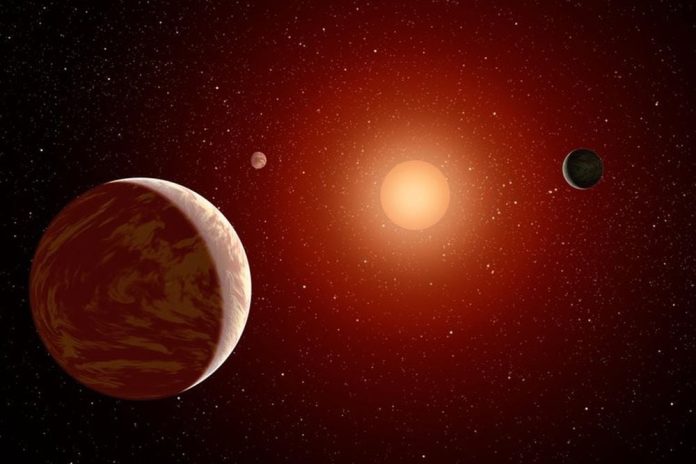
When astronomers first discovered exoplanets, they found massive ones orbiting large stars.
The technology to detect smaller planets around low-mass, dim red dwarfs took time to develop.
By the mid-2000s, HARPS (High Accuracy Radial velocity Planet Searcher) was specifically targeting M dwarfs and in 2009 discovered the least massive exoplanet at the time.
In 2016, the CARMENES instrument joined the effort and began its survey of M dwarf stars.
It’s mounted on the Spanish Calar Alto telescope and its mission is to examine about 300 M dwarfs for signs of Earth-like exoplanets.
CARMENES uses the radial velocity method to detect planets tugging on their stars, and so far has discovered many short-orbit exoplanets around stars with masses below 0.34 solar masses.
New research in Astronomy and Astrophysics announces the discovery of more Earth-like planets around even lower mass stars.
It’s titled “The CARMENES search for exoplanets around M dwarfs: Occurrence rates of Earth-like planets around very low-mass stars.” The lead author is Dr. Adrian Kaminski from the Center for Astronomy and Heidelberg University.
“Previous estimates of planet occurrence rates in the CARMENES survey indicated increased numbers of planets on short orbits for M dwarfs with masses below 0.34 Earth masses,” the researchers write.
This new research is focused on the lowest-mass stars in the CARMENES (Calar Alto high-Resolution search for M dwarfs with Exoearths with Near-infrared and optical Échelle Spectrographs) data. The research team examined 15 stars from the 2,200 M dwarf stars in the CARMENES data.
They identified four new exoplanets orbiting three stars. Three of them are between 1.03 and 1.52 Earth masses and have orbital periods from 1.43 to 5.45 days. The fourth is much more massive, about 14 Earth masses, and follows a much longer orbital period of about 3.3 years. The planets are G 268– 110 b, G 261–6 b, and G 192–15 b and c. G 192–15 c is the massive planet.
Finding Earth-like planets around M dwarfs is intriguing because they’re the most abundant star type in the Milky Way.
They’re small and dim and difficult to see, but astronomers think that up to 75% of Milky Way stars could be M dwarfs. These low-mass stars burn their hydrogen fuel very slowly and have extremely long lives. This stability means that planets in habitable zones around red dwarfs could be ideal hosts for life, though there’s a lot more to learn before that conclusion is solidified.
Thanks to NASA’s Kepler mission and other observational efforts, we know that at least 50% of M dwarfs host planets and many of them host multiple planets. The well-known TRAPPIST-1 system best exemplifies this. Observations also show that many of these planets are quite close to the dim stars, potentially in their habitable zones where liquid water persists on their surfaces.
In their statistical analyses of the data, the researchers found that planets with less than three Earth masses are common around low-mass stars. “For planets below 3 M⊕ we found rates consistent with one planet per star across all investigated periods, but the rates decrease almost by an order of magnitude for larger planet masses up to 10 M⊕,” they write.
They also found that occurrence rates are quite dependent on stellar masses. “Our findings confirm that planet occurrence rates vary with stellar masses even among M dwarfs, as we found more planets with lower masses and on shorter orbits in our subsample of very low-mass stars compared to more massive M dwarfs,” they explain.
The end result of the analysis that stars with less than 0.16 solar masses host an average of about two planets below three Earth masses. On the other hand, larger planets occur much less frequently.
“It is quite remarkable how often small planets occur around very low-mass stars,” said lead author Kaminski. “This suggests that low-mass stars tend to form smaller planets in close orbits.”
This conclusion reflects other research into planet formation. Many exoplanet systems feature multiple planets on short period orbits. Earth-like planets in these system are becoming prime targets in the search for habitability.
“Small, rocky planets in the so-called habitable zone—the area around a star where water could exist in liquid form—are potential candidates for habitable worlds,” said co-author Dr. Andreas Quirrenbach, director of the Königstuhl Observatory. “Since M-dwarfs are very common and radiate their energy constantly into space over billions of years, they could provide stable environments for the development of life,” Quirrenbach said in a press release.
The researchers point out that there are definite uncertainties in their derived rates of small planet occurrences. “Still, one should take note of the high uncertainties of the estimated rates, which are due to the small number statistics,” the authors write in their research. “The analyzed sample contains only 15 stars and 11 already detected planets that lie within our range of period of interest and that could be identified with CARMENES RVs alone.” They also explain that they could still be underestimating the number of low-mass planets on wide orbits.
The research shows that it’s important to differentiate stellar masses when researching planetary occurrences and planetary formation rates. While this work is based on a subset of the CARMENES data, a deeper investigation will take place once CARMENES is complete.
“Once the CARMENES survey of M dwarfs is completed and at least 50 RV epochs have been obtained for all targets, we will conclude our analysis of occurrence rates on the entire sample,” the authors conclude.
Written by Evan Gough/Universe Today.



